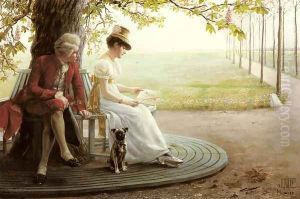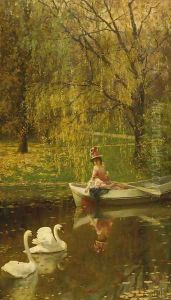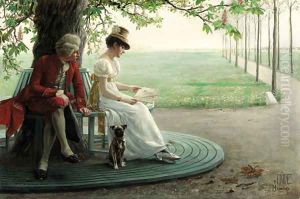Felix Friedrich Von Ende Paintings
Felix Friedrich von Ende was a German painter known for his detailed genre scenes, landscapes, and portraits, capturing the essence of the late 19th and early 20th centuries with a particular focus on the daily life and customs of his time. Born on February 4, 1856, in Schwedt, Prussia (now in modern-day Germany), von Ende was part of a generation of artists who sought to depict the world around them with a keen eye for realism and an appreciation for the nuances of human and natural beauty.
Von Ende received his formal art education at the Prussian Academy of Arts in Berlin, where he was influenced by the teachings of several prominent artists of the period. His style was further developed and refined through his travels and studies in other parts of Germany and Europe, including a significant period in Italy, which was a common practice among artists of his era seeking inspiration and mastery in their craft.
Early in his career, von Ende was primarily known for his genre scenes, which often depicted the rural and urban life of Germany with a particular interest in the social interactions and customs of its people. These paintings were celebrated for their attention to detail, vibrant color palette, and the ability to convey narrative and emotion through visual means. As his career progressed, von Ende expanded his repertoire to include landscapes and portraits, demonstrating a versatile ability to capture both the tranquility of nature and the complexity of the human condition.
Throughout his life, Felix Friedrich von Ende was an active participant in the German art scene, contributing to exhibitions and engaging with contemporary artistic movements, though he remained true to his realistic and detailed style rather than fully embracing the emerging avant-garde trends of the late 19th and early 20th centuries. His work received acclaim in his lifetime and was collected by both private patrons and public institutions.
Von Ende's legacy is that of a skilled observer of his time, an artist who managed to capture the essence of the world around him with both accuracy and artistic sensitivity. He passed away on December 17, 1929, in Berlin, leaving behind a body of work that continues to be appreciated for its historical value and artistic quality. His paintings offer a window into the life and times of his era, reflecting the social and cultural atmosphere of Germany at the turn of the century.


